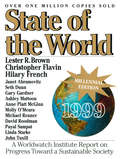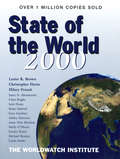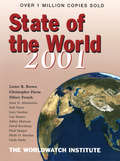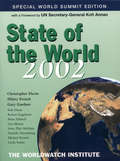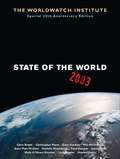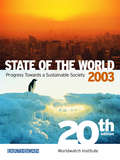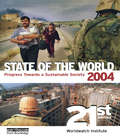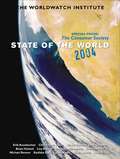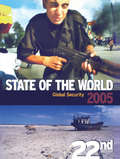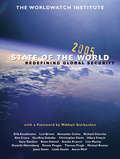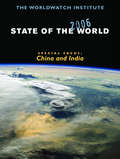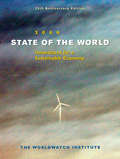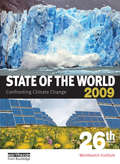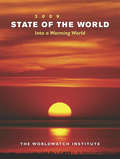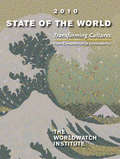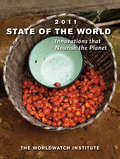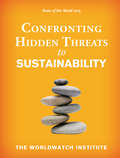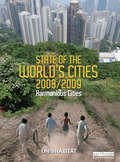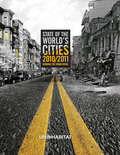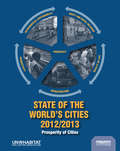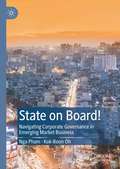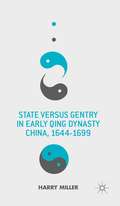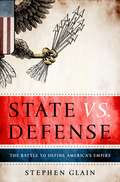- Table View
- List View
State of the World 1999: A Worldwatch Institute Report On Progress Toward A Sustainable Society (State of the World)
by The Worldwatch InstituteWritten in clear and concise language, with easy-to-read charts and tables, State of the World presents a view of our changing world that we cannot afford to ignore.
State of the World 2000: A Worldwatch Institute Report On Progress Toward A Sustainable Society (State of the World)
by The Worldwatch InstituteState of the World 2000 shines a sharp light on the great challenge our civilization faces: how to use our political systems to manage the difficult and complex relationships between the global economy and the Earth's ecosystems. If we cannot build an environmentally sustainable global economy, then we have no future that anyone would desire.
State of the World 2001
by The Worldwatch InstituteFrom the thinning of the Arctic sea ice to the invasion of the mosquito-borne West Nile virus, State of the World 2001 shows how the economic boom of the last decade has damaged natural systems. The increasingly visible evidence of environmental deterioration is only the tip of a much more dangerous problem: the growing inequities in wealth and income between countries and within countries, inequities that will generate enormous social unrest and pressure for change.
State of the World 2002 (State of the World)
by The Worldwatch InstituteState of the World 2002 includes chapters on climate change, farming, toxic chemicals, sustainable tourism, population, resource conflicts and global governance
State of the World 2003 (State of the World)
by The Worldwatch InstituteThe challenges are still immense, of course, as the book also documents, but the building blocks for a historic reinvention of human civilization are now within reach.
State of the World 2003: Progress Towards a Sustainable Society
by Worldwatch InstituteThis volume takes a look at the trends that have put the global economy on a collision course with the Earth's ecosystems. It aims to provide a vital synthesis ranging across a wide spectrum of both the social and natural sciences. Published annually in 28 languages, each edition draws on the knowledge of the Worldwatch Institute's team of writers and researchers.
State of the World 2004: Progress Towards a Sustainable Society
by Worldwatch InstituteState of the World 2004 takes a fresh look at the trends that have put the global economy on a collision course with the Earth's ecosystems. This year's edition has a special focus on the theme of consumption. It questions whether a less-consumptive society is possible; and concludes that it is essential. The book explores overconsumption, a by-product of affluence; and underconsumption, linked to poverty, and provides 'behind the scenes' exposes of the devastating environmental impacts of some of our most popular products, from plastic bags, to paper, to mobile phones. Published annually in 28 languages, each edition draws on the breadth of expertise of Worldwatch's award-winning team of writers and researchers. State of the World is relied upon by national governments, UN agencies, development workers and law-makers for its authoritative and up-to-the-minute analysis and information. It is essential for anyone concerned with building a positive, global future.
State of the World 2004: The Consumer Society (State of the World)
by The Worldwatch InstituteWith chapters on food, water, energy, the politics of consumption and redefining the good life, Worldwatch's award-winning research team asks whether a less-consumptive society is possible--and then argues that it is essential.
State of the World 2005: Global Security
by Worldwatch InstituteState of the World 2005 takes a new and deeper look at the theme that has dominated international politics since 9/11: security. Not the armed conflicts that occur when it breaks down, but the underlying social, economic and environmental pressures which determine how threatened and vulnerable people feel. These include food, water, other natural resources, exposure to environmental change and health threats. Without equitable and sustainable management of these conditions, lasting security cannot be achieved. The result is a fascinating and illuminating volume that offers a new definition of security and the means to achieve it. [Published annually in 28 languages, each edition draws on the breadth of expertise of the Worldwatch Institute's team of writers and researchers. State of the World is relied upon by national governments, UN agencies, development workers and law-makers for its authoritative and up-to-the-minute analysis and information. It is essential for anyone concerned with building a positive, global future.]
State of the World 2005: Redefining Global Security (State of the World)
by The Worldwatch InstituteIn State of the World 2005, Worldwatch researchers explore underlying sources of global insecurity including poverty, infectious disease, environmental degradation, and rising competition over oil and other resources. Find out why terrorism is just symptomatic of a far broader set of complex problems that require more than a military response.
State of the World 2006: China and India (State of the World #0)
by The Worldwatch InstituteState of the World 2006 provides a special focus on China and India and their impact on the world as major consumers of resources and polluters of local and global ecosystems. The report explains the critical need for both countries to "leapfrog" the technologies, policies, and even the cultures that now prevail in many western countries for the sake of global sustainability--and reports on some of the strategies that China and India are starting to implement. Besides the focus on China and India, State of the World 2006 looks at actions corporations can take to be more socially responsible; examines the potential socioeconomic, health, and environmental implications of nanoscale technologies; assesses the impacts of large-scale development of biofuels on agriculture and the environment; describes mercury sources, industrial uses, and health hazards worldwide; and provides an overview of the need to safeguard freshwater ecosystems, with examples of proven approaches in cities, villages, and farming regions around the world.
State of the World 2007: Our Urban Future (State of the World)
by The Worldwatch InstituteIn 2008, half of the Earth's population will live in urban areas, marking the first time in history that humans are an urban species. State of the World 2007: Our Urban Future examines changes in the ways cities are managed, built, and lived in that could tip the balance towards a healthier and more peaceful urban future.
State of the World 2008: Innovations for a Sustainable Economy (State of the World)
by The Worldwatch InstituteEnvironmental issues were once regarded as irrelevant to economic activity, but today they are dramatically rewriting the rules for business, investors, and consumers. Around the world, innovative responses to climate change and other environmental problems are affecting more than $100 billion in annual capital flows as pioneering entrepreneurs, organizations, and governments take steps to create the Earth's first "sustainable" global economy.
State of the World 2009: Confronting Climate Change
by Worldwatch InstituteThe year 2009 will be pivotal for Earth's climate. As scientists warn that we have only a few years to reverse the rise in greenhouse gas emissions if we are to avoid abrupt and catastrophic climate change, the world community has agreed to finalize negotiations on a new climate agreement in Copenhagen in late 2009. Intended to inject new inspiration and energy into national and international climate negotiations, this 26th edition of State of the World examines the steps we urgently need to take to prevent a global catastrophe while adapting to the now inevitable climatic shifts already set in motion. As well as the profound, long-term consequences of global warming, this volume explores the policy changes needed and the benefits that will flow from the transition to a low-carbon economy. It also includes 22 summaries on the many important issues linked to climate change, plus a Climate Change Reference Guide and Glossary. Published annually in 28 languages, State of the World is long established as the most authoritative and accessible annual guide to our progress towards a sustainable future. It is relied upon by national governments, UN agencies, development workers and law-makers for its up-to-the-minute analysis and information. Essential reading for anyone concerned with building a positive, global future.
State of the World 2009: Into a Warming World
by The Worldwatch InstituteIt's New Year's Day, 2101. Somehow, humanity survived the worst of global warming--the higher temperatures and sea levels and the more intense droughts and storms--and succeeded in stabilizing the Earth's climate. Greenhouse gas concentrations are peaking and are expected to drift downward in the 22nd century. The rise in global temperatures is slowing and the natural world is gradually healing. The social contract largely held. And humanity as a whole is better fed, healthier, and more prosperous today than it was a century ago. This scenario of an imagined future raises a key question: What must we do in the 21st century to make such a future possible, and to head off the kind of climate catastrophe that many scientists now see as likely? This question inspires the theme of the Worldwatch Institute's State of the World 2009 report: how climate change will play out over the coming century, and what steps we most urgently need to take now.
State of the World 2010: Transforming Cultures From Consumerism to Sustainability (State of the World)
by The Worldwatch InstituteLike a tsunami, consumerism has engulfed human cultures and Earth's ecosystems. Left unaddressed, we risk global disaster. But if we channel this wave, intentionally transforming our cultures to center on sustainability, we will not only prevent catastrophe, but may usher in an era of sustainability--one that allows all people to thrive while protecting, even restoring, Earth. In State of the World 2010, sixty renowned researchers and practitioners describe how we can harness the world's leading institutions--education, the media, business, governments, traditions, and social movements--to reorient cultures toward sustainability.
State of the World 2011: Innovations that Nourish the Planet (State of the World)
by The Worldwatch InstituteA compelling look at the global food crisis, with particular emphasis on global innovations that can help solve a worldwide problem. State of the World 2011 not only introduces us to the latest agro-ecological innovations and their global applicability but also gives broader insights into issues including poverty, international politics, and even gender equity.
State of the World 2014: Governing for Sustainability (State of the World)
by David W. Orr The Worldwatch Institute Michael Renner Tom Prugh Conor Seyle Matthew Wilburn KingCitizens expect their governments to lead on sustainability. But from largely disappointing international conferences like Rio II to the U.S.'s failure to pass meaningful climate legislation, governments' progress has been lackluster. That's not to say leadership is absent; it just often comes from the bottom up rather than the top down. Action--on climate, species loss, inequity, and other sustainability crises--is being driven by local, people's, women's, and grassroots movements around the world, often in opposition to the agendas pursued by governments and big corporations. These diverse efforts are the subject of the latest volume in the Worldwatch Institute's highly regarded State of the World series. The 2014 edition, marking the Institute's 40th anniversary, examines both barriers to responsible political and economic governance as well as gridlock-shattering new ideas. The authors analyze a variety of trends and proposals, including regional and local climate initiatives, the rise of benefit corporations and worker-owned firms, the need for energy democracy, the Internet's impact on sustainability, and the importance of eco-literacy. A consistent thread throughout the book is that informed and engaged citizens are key to better governance. The book is a clear-eyed yet ultimately optimistic assessment of citizens' ability to govern for sustainability. By highlighting both obstacles and opportunities, State of the World 2014 shows how to effect change within and beyond the halls of government. This volume will be especially useful for policymakers, environmental nonprofits, students of environmental studies, sustainability, or economics--and citizens looking to jumpstart significant change around the world.
State of the World 2015
by The Worldwatch The Worldwatch InstituteWe think we understand environmental damage: pollution, water scarcity, a warming world. But these problems are just the tip of the iceberg. Food insecurity, financial assets drained of value by environmental damage, and a rapid rise in diseases of animal originare among the underreported consequences of an unsustainable global system. In State of the World 2015, the flagship publication of The Worldwatch Institute, experts explore hidden threats to sustainability and howto address them. How will nations deal with migration as climate change refugees cross borders in order to escape flooding, drought, or other extreme weather events? What will happen to the price and availability offossil energy--the foundation of industrial civilization--as these resources oscillate between surplus and scarcity? If perpetual economic growth on a finite planet is impossible, what are the alternatives? Can national governments manage the transition?Eight key issues are addressed in depth,along with the central question ofhow we can develop resilience to these and other shocks. For decades, The Worldwatch Institute has been a leader in identifying and analyzing emerging environmental threats. With the latest edition of State of The World, the authorities at Worldwatch bring to light challenges we can no longer afford to ignore.
State of the World's Cities 2008/9: Harmonious Cities
by Un-HabitatCities are perhaps one of humanity's most complex creations, never finished, never definitive. They are like a journey that never ends. Their evolution is determined by their ascent into greatness or their descent into decline. They are the past, the present and the future. Cities contain both order and chaos. In them reside beauty and ugliness, virtue and vice. They can bring out the best or the worst in humankind. They are the physical manifestation of history and culture and incubators of innovation, industry, technology, entrepreneurship and creativity. Cities are the materialization of humanity's noblest ideas, ambitions and aspirations but when not planned or governed properly, can be the repository of society's ills. Cities drive national economies by creating wealth, enhancing social development and providing employment but they can also be the breeding grounds for poverty, exclusion and environmental degradation. The 21st Century is the Century of the City. Half of humanity now lives in cities, and within the next two decades, 60 per cent of the world's people will reside in urban areas. How can city planners and policymakers harmonize the various interests, diversity and inherent contradictions within cities? What ingredients are needed to create harmony between the physical, social, environmental and cultural aspects of a city and the human beings that inhabit it? This report adopts the concept of Harmonious Cities as a theoretical framework in order to understand today's urban world, and also as an operational tool to confront the most important challenges facing urban areas and their development processes. It recognizes that tolerance, diversity, social justice and good governance, all of which are inter-related, are as important to sustainable urban development as physical planning. It addresses national concerns by searching for solutions at the city level. For that purpose, it focuses on three key areas: spatial or regional harmony, which examines the main drivers of urban growth in the developing world and explores the spatial nuances of economic and social policies; social harmony, which presents and analyzes new data on urban inequalities worldwide and describes the types of shelter deprivations experienced by slum dwellers in developing world regions; and environmental harmony, which examines the role of cities in the climate change debate, and the impact of global warming on the most vulnerable cities. The report also assesses the various intangible assets within cities that contribute to harmony, such as cultural heritage, sense of place and memory and the complex set of social and symbolic relationships that give cities meaning. It argues that these intangible assets represent the soul of the city and are as important for harmonious urban development as tangible assets. Harmony within cities, argues the report, is both a journey and a destination. Published with UN-HABITAT
State of the World's Cities 2010/11: Bridging the Urban Divide
by Un-HabitatThe world's urban population now exceeds the world's rural population. What does this mean for the state of our cities, given the strain this global demographic shift is placing upon current urban infrastructures? Following on from previous State of the World's Cities reports, this edition uses the framework of 'The Urban Divide' to analyse the complex social, political, economic and cultural dynamics of urban environments. In particular, the book focuses on the concept of the 'right to the city' and ways in which many urban dwellers are excluded from the advantages of city life, using the framework to explore links among poverty, inequality, slum formation and economic growth. The volume will be essential reading for all professionals and policymakers in the field, as well as a valuable resource for researchers and students in all aspects of urban development. Published with UN-Habitat.
State of the World's Cities 2012/2013: Prosperity of Cities
by Un HabitatThe city is the home of prosperity. It is the place where human beings find satisfaction of basic needs and access to essential public goods. The city is also where ambitions, aspirations and other material and immaterial aspects of life are realized, providing contentment and happiness. It is a locus at which the prospects of prosperity and individual and collective well-being can be increased. However, when prosperity is restricted to some groups, when it is used to pursue specific interests, or when it is a justification for financial gains for the few to the detriment of the majority, the city becomes the arena where the right to shared prosperity is claimed and fought for. As people in the latter part of 2011 gathered in Cairo’s Tahrir Square, in Madrid’s Puerta del Sol, in front of London’s St Paul’s cathedral, or in New York’s Zuccotti Park, they were not only demanding more equality and inclusion; they were also expressing the need for prosperity to be shared across all segments of society. What this new edition of State of the World’s Cities shows is that prosperity for all has been compromised by a narrow focus on economic growth. UN-Habitat suggests a fresh approach to prosperity beyond the solely economic emphasis, including other vital dimensions such as quality of life, adequate infrastructures, equity and environmental sustainability. The Report proposes a new tool – the City Prosperity Index – together with a conceptual matrix, the Wheel of Prosperity, both of which are meant to assist decision makers to design clear policy interventions. The Report advocates for the need of cities to enhance the public realm, expand public goods and consolidate rights to the 'commons' for all as a way to expand prosperity. This comes in response to the observed trend of enclosing or restricting these goods and commons in enclaves of prosperity, or depleting them through unsustainable use. The Report maps out major policy steps to promote a new type of city – the city of the twenty-first century – that is a 'good', people-centred city. One that is capable of integrating the tangible and more intangible aspects of prosperity, and in the process shedding off the inefficient, unsustainable forms and functionalities of the city of the previous century. By doing this, UN-Habitat plays a pivotal role in ensuring that urban planning, legal, regulatory and institutional frameworks become instruments of prosperity and well-being.
State on Board!: Navigating Corporate Governance in Emerging Market Business
by Nga Pham Kok-Boon OhResearch in this book focuses on the strategic behaviour of the State as a shareholder in businesses, and the implications it has for the other shareholder(s) and business performance. It investigates the institutional characteristics of State-linked and State-owned firms (SIEs & SOEs), in emerging markets using Vietnam as a case study with comparative analysis on China and selected ASEAN countries.In doing so, the book adopts an evidence-based approach to explain the State’s role as a shareholder in the different aspects of corporate governance, including CEO appointment, board structure and impact of State ownership on business strategy and performance. It highlights the influence of the State as a shareholder by investigating institutional factors consistent with “path dependence” theory, which postulates that the initial and underlying structure of an economy influences its performance. In addition, the book presents empirical evidence of the dynamics of corporate governance arising from interactions between the State and other shareholders, which has not yet been addressed in the literature, and is distinctive in providing new insights from both qualitative and empirical research on how to successfully navigate the emerging market business environments from the perspective of the State as an “owner-participant”. Explaining the theoretical constructs in corporate governance in State-invested firms, empirical research methodologies, and results to draw and validate inferences, the book is comprehensive and provides a practical guide for practitioners as well as a reference for academics, undergraduate and postgraduate students. The new theoretical models proposed integrate traditional political-economic and agency theories, which also underpin tertiary business courses and academic research.
State versus Gentry in Early Qing Dynasty China, 1644–1699
by Harry MillerContinuing the argument developed in the author's previous book, this exhaustively researched study describes the humiliation of the Chinese gentry at the hands of the statist Oboi regents in the 1660s and the Kangxi emperor's self-declared Confucian sagehood in the 1670s, which effectively trumped the gentry's claim to sovereignty.
State vs. Defense: The Battle to Define America's Empire
by Stephen GlainA masterful account of how sixty years of American militarism created the Cold War, fanned decades of unnecessary conflict, helped to fuel Islamist terror, and threatens to bankrupt the country. For most of the twentieth century, the sword has led before the olive branch in American foreign policy. In eye-opening fashion, State vs. Defense shows how America truly operates as a superpower and explores the constant tension between the diplomats at State and the warriors at Defense. State vs. Defense characterizes all the great figures who crafted American foreign policy, from George Marshall to Robert McNamara to Henry Kissinger to Don Rumsfeld with this underlying theme: America has become increasingly imperial and militaristic. Take, for example, the Pentagon, which as of 2010, acknowledged the concentration of 190,000 troops and 115,000 civilian employees inside 909 military facilities in 46 countries and territories. The price of America's military-base network overseas, along with the expense of its national security state at home, is enormous. The bill comes in at well over $1 trillion. That is equal to nearly 8 percent of GDP and more than 20 percent of the federal budget. (By comparison, China, Russia, Cuba, Iran, and North Korea, the five countries Pentagon planners routinely trot out as conventional threats to the national well-being, have a cumulative security budget of just over $200 billion.) Quietly, gradually--and inevitably, given the weight of its colossal budget and imperial writ--the Pentagon has all but eclipsed the State Department at the center of U.S. foreign policy. In the tradition of classics such as The Wise Men, The Best and the Brightest, and Legacy of Ashes, State vs. Defense explores how and why American leaders succumbed to the sirens of militarism, how the republic has been lost to an empire, and how "the military-industrial complex" that Eisenhower so famously forewarned has set us on a stark path of financial peril.
